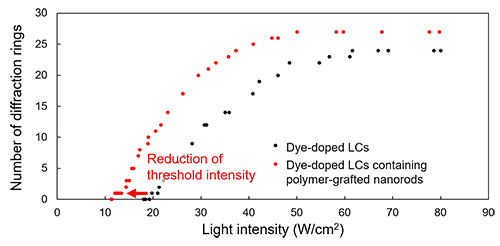Latest Research
- 2024.07.25
- Shishido-Kubo Group
Enhancement of Nonlinear Optical Effects of Dye-Doped Liquid Crystals by Liquid-crystalline Polymer-grafted Nanorods
Inorganic nanorods have attracted great attention due to their potential application in functional materials utilizing their remarkable properties derived from their size effects and anisotropic shapes. Moreover, nanorods can also work as nanofillers to enhance the functionality of host materials. To fully harness the potential of these nanorods, it is crucial to prevent their aggregation and maintain good dispersion in host materials. We have previously demonstrated that surface-modification of nanorods with liquid-crystalline (LC) polymers enhances their miscibility to host LCs and enables unidirectional alignment cooperatively with host LCs [1,2].
Here, we present the effect of LC polymer-grafted nanorods on molecular reorientation based on the nonlinear optical (NLO) effects of LCs. NLO materials play a crucial role in the development of next-generation optical switching and self-modulation devices. LCs, in particular, are widely studied as NLO materials due to their significant molecular anisotropy and responsiveness to optical fields. However, high light intensities are required to induce molecular reorientation of LCs, which hinders low-threshold operation in optical devices. This study aims to achieve molecular reorientation at lower threshold intensities by introducing nanorods into oligothiophene dye-doped LCs. It was confirmed that adding LC polymer-grafted ZnO nanorods, which are miscible to dye-doped LC hosts, reduced the threshold intensity for light-induced molecular reorientation by 39% [3].
The compounds used in this study are shown in Figure 1. According to previous reports, ZnO nanorods with an average diameter of 7 nm and a length of 50 nm were synthesized, and LC polymers were grown on their surfaces via surface-initiated atom transfer radical polymerization [1]. The obtained LC polymer-grafted ZnO nanorods were added to oligothiophene dye (TR5)-doped LC (5CB) host. Differential scanning calorimetry confirmed that the polymer-modified nanorod-containing dye-doped LCs exhibited a single LC phase to isotropic phase transition, indicating miscibility of the polymer-grafted nanorods with the host. The prepared dye-doped LCs containing polymer-grafted nanorods were injected in glass cells treated with homeotropic alignment layers. The conoscopic polarized optical microscopy and polarized UV-visible absorption spectroscopy confirmed the homeotropic alignment of LC molecules.
 |
|
| Figure 1. Chemical structures of the materials used in this study. |
The LC cell was irradiated with laser light at a wavelength of 488 nm, where the TR5 dye absorbs, to evaluate light-induced molecular reorientation. Below the threshold intensity for light-induced molecular reorientation, the transmitted laser beam shape remained unchanged, while irradiation with sufficient laser intensity formed concentric rings (Figure 2). This ring formation is a typical nonlinear optical effect resulting from self-focusing and self-phase modulation due to refractive index changes caused by the reorientation of anisotropic molecules.
The number of diffraction rings was counted while varying the incident light intensity. It was revealed that the number of rings increased with higher incident light intensities. The light intensity required to cause one diffraction ring was defined as the threshold intensity, and the effect of polymer-modified nanorods on this threshold was investigated. The dye-doped LCs containing polymer-grafted nanorods exhibited a significant decrease in the threshold intensity. Specifically, the system containing 5 wt% polymer-grafted ZnO nanorods had a threshold intensity of 12.0 W/cm², a 39% reduction compared to 19.7 W/cm² for the pure dye-doped LCs without polymer-grafted nanorods (Figure 3). On the other hand, when only the LC homopolymer was added to dye-doped LCs with the same weight fraction as that of LC polymers grafted from nanorods, the threshold was 15.2 W/cm², with only a 23% reduction. This indicates that the presence of nanorods significantly influences the threshold reduction. This threshold reduction is attributed to the decreased alignment order of the host LCs caused by the addition of polymer-grafted nanorods, making orientation changes along the polarization direction of the incident laser beam.
 |
|
| Figure 3. | Relationship between incident light intensity and number of diffraction rings. (Reproduced from Ref. 3 with permission from the Royal Society of Chemistry) |
These results are significant for the development of new optical devices, including optical switching, self-modulation, and holographic memory. Furthermore, the findings suggest the potential for further advancements in systems utilizing polymer-grafted nanorods, offering the way for future miniature optical devices and lenses.
| [1] | S. Kubo, R. Taguchi, S. Hadano, M. Narita, O. Watanabe, T. Iyoda, M. Nakagawa, ACS Appl. Mater. Interfaces 6, 811-818 (2014). |
| [2] | K. Ogata, K. Matsumoto, Y. Kobayashi, S. Kubo, A. Shishido, Molecules, 27, 689 (2022). |
| [3] | J. C. Mejia, K. Matsumoto, K. Ogata, D. Taguchi, K. Nakano, S. Kubo, A. Shishido, Mater. Adv., 3, 7531 (2022). |




